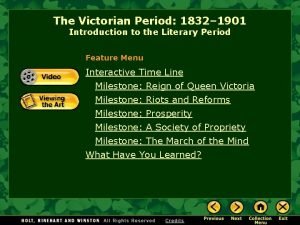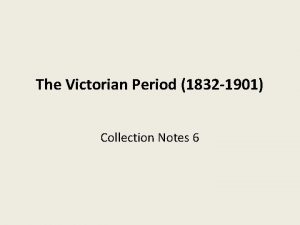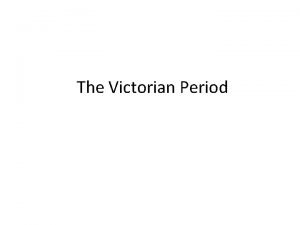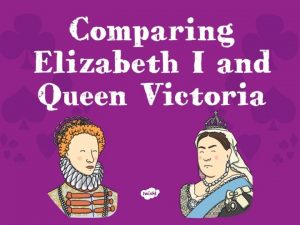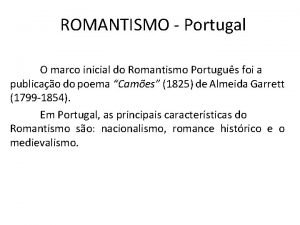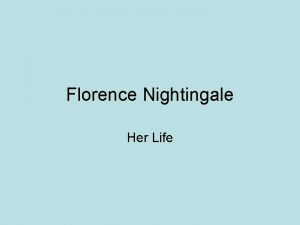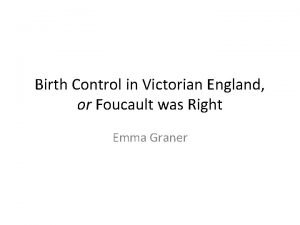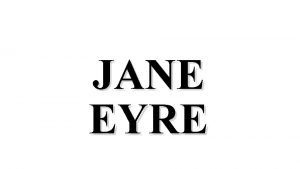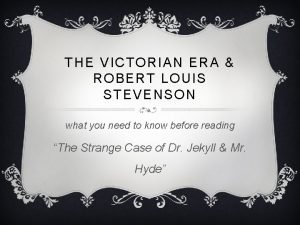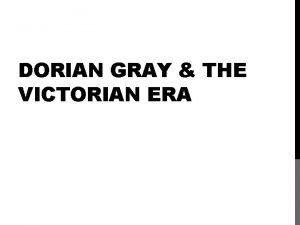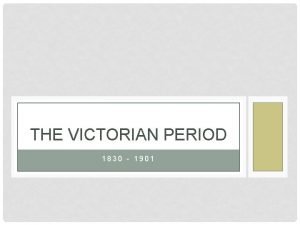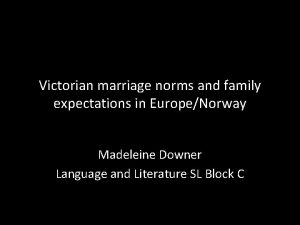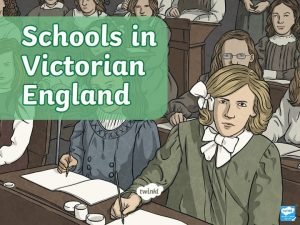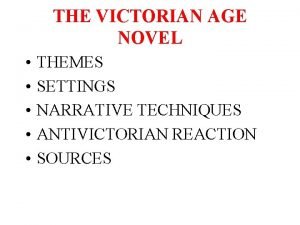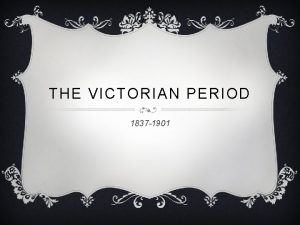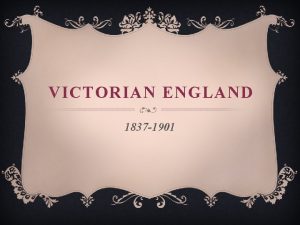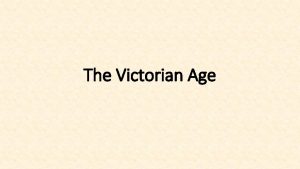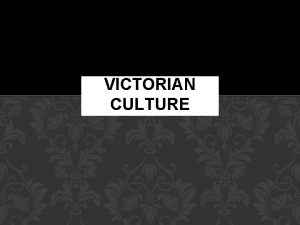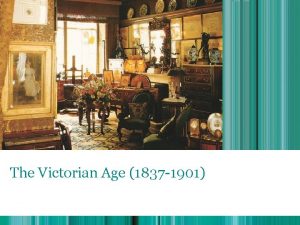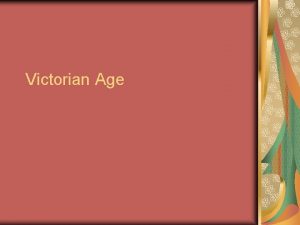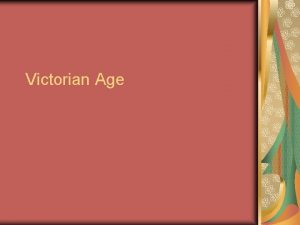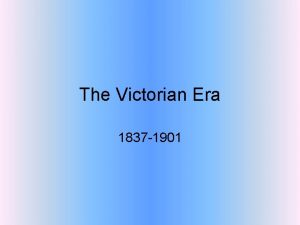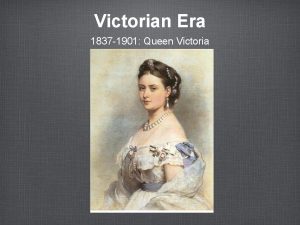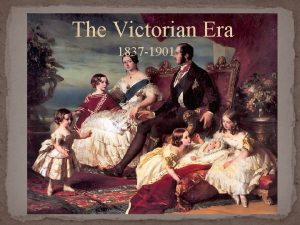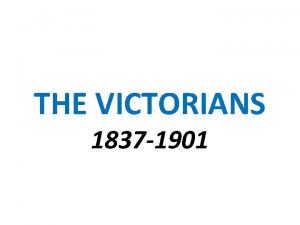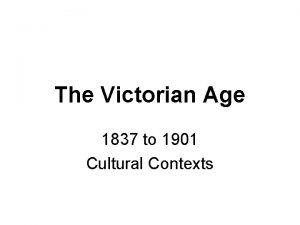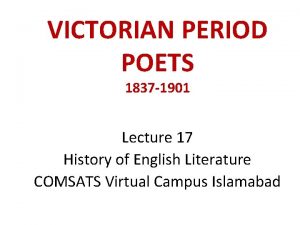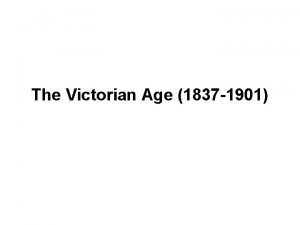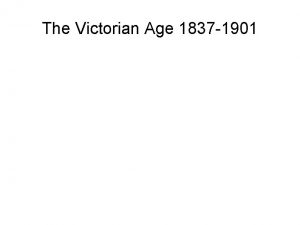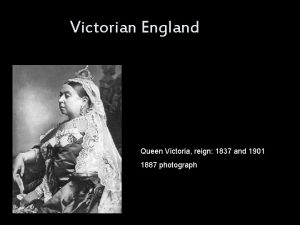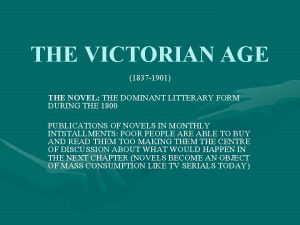The Victorian Era 1837 1901 An Era of























- Slides: 23

The Victorian Era 1837 -1901 An Era of Change and Contradiction

Victorian England 1832 -1901 Great Exhibition Hall 1851 represents 19 th century progress!

This view of 19 th century London shows the darker side of progress, the Industrial Revolution at its height.

Interesting Facts 1827: First photographs taken with the Camera Obscura 1848: Women begin attending University of London 1850: Life Insurance introduced 1851: Gold discovered 1860: Florence Nightingale founds school for nurses 1876: Alexander Graham Bell patents the telephone 1877: Thomas Alva Edison patents the phonograph 1886: Wimbledon opens 1888: Jack the Ripper stalks London’s East End

The Era Generally, the Victorian Era is divided into 3 sections: The Early Period (1830 -1848): A Time of Trouble and Social Unrest The Mid-Victorian Period (1848 -70): Economic Prosperity, the Growth of the Empire and Religious Controversy The Late Period (1870 -1901): Decay of Victorian Values Some familiar authors who made this period famous: Charles Dickens Jane Austen Charlotte and Emily Bronte Oscar Wilde Joseph Conrad Rudyard Kipling Bram Stoker Alfred Lord Tennyson T. H. Huxley H. G. Wells Sir Arthur Conan Doyle Bernard Shaw Charles Darwin Edith Hamilton This Literary period is one of the richest literary periods in Britain.

Victorian Background Follows the reign of Queen Victoria Parallels the Renaissance– there is an expansion of wealth, power and culture

Life of Queen Victoria gained the throne at age 18 She associated with England’s industrialization, economic expansion and imperialism. By the time of her death, it was said that England was “an empire upon which the sun never set. ” She married Prince Albert in 1840. Albert had many interests in science, the arts, trade and industry. He is best known for establishing many of the museums in London.

Queen Victoria Continued Until the late 1860 s, Queen Victoria rarely made public appearances. There were several attempts on her life between 1840 and 1880. With family encouragement, Queen Victoria finally reentered the public arena following the death of her devoted husband. During Victoria's long reign, the crown lost much of its direct power. A series of Acts broadened the social and economic base of the parliament and prime minister. This gave voters and individuals in England more say in English politics.

End of Queen Victoria’s Life Even though Queen Victoria lost much of her sovereign power, she was well liked and was able to influence many of parliament’s decisions. She was a strong supporter of the Empire, which flourished under her rule. She was a proponent of education and aid to the poor and ran many charities. She continued to work until the day of her death, having just returned from visits to Ireland South Africa. Victoria had the longest rule of 64 years when she died in 1901.

Victorian Era ENGLAND IN FLUX

Changes in England continued to expand industrially under Victoria. By 1848, England produced as much iron as the rest of the world combined. The number of people in England doubled between 1801 and 1850. Cities continued to grow. According to author Disraeli, there were “two nations” in England – the rich and the poor. This is the Early Period.

Life for the Poor Many people believed that this widespread death and poverty was a trade for England’s growing power If there was a depression in the trade market, an entire factory could be unemployed. This led to extreme poverty and urban slums, leaving many families in outdoor slums in the bitter English winters.

Potato Famine The 1840 s brought the Potato Famine to Ireland. In two years, a million people died. This brought many more starving poor into England’s already crowded streets.

Unrest in England The 1840 s were the worst years in the century for unemployment, hunger and disease. This led to social unrest. Universal male suffrage came in 1884. Change was the only constant. People began to trust in progress. The Education Act of 1891 created free schools for everyone up until age 12.

The Empire Up until the 1870 s, most Englishmen viewed the colonies like India as economic burdens. With new commercial rivals, the English viewed their colonies in a new light: as means to expand their trade. This is the era of “White Man’s Burden” - The English believed that it was their preordained purpose to civilize the world.

The Empire Continued England’s “civilization” of the rest of the world was not usually civil. Among other problems, it led to religious unrest in Ireland in the 1880 s. This religious war continues today.

The Victorian Era A CHANGING SOCIAL CLIMATE

Religion and other changes The rise of science causes a serious question of religion. This is the era of Darwin and Freud. Writers no longer just wrote “art” – they took on political responsibility in their writing. This is the era of the novel. There is also a revival of the drama in England. In the beginning of the Victorian period, magazines printed novels in installments. This declined in late Victorian England, leading to a new creation: the British short story.

Changing Climate With all the changes in social and political issues, the Victorians clung to one thing: decorum and moral values. This led to a prudish and conservative view on life, sexuality, class, and language that this era is famous for. Most common themes in Victorian Literature: Sexuality and gender issues Imperialism and the ethics of the Empire Industrialism Innocence and morality Religion Fear and science

Children and Fairy Literature The period also shifted the views of childhood heeding the works of the Romantic poets like Wordsworth and Blake. This is at least a changing view for upper class children. The following works appear in this period: Little Women Black Beauty Treasure Island Robinson Crusoe Alice in Wonderland Beatrix Potter books The Jungle Book The Wizard of Oz (American) The Frog Prince Coral Island The Fairy Books A Little Princess While not British, this is also the era when Fairy Tales such as Grimm and Hans Christian Anderson rise to popularity.

End of the Era—Changes for Women The Custody Act (1839) gave a mother the right to petition the court for access to her minor children and custody of children under 7 and later 16. The Divorce and Matrimonial Causes Act (1857) Married Women’s Property Acts (1870) 1891 – women gain divorce rights 1848 – First women’s college established in London By the end of Victoria’s reign, women could take degrees at 12 university colleges.

Interesting clothing note: Women's clothing symbolized their constricted lives. Tight lacing into corsets and cumbersome, multiple layers of skirts which dragged on the ground impeded women's freedom of movement. Between 1856 and 1878, among the wealthy, the cage crinoline was popular as it replaced the many layers of petticoats, but it was cumbersome and humiliating. Sitting down, the cage rode up embarrassingly at the front. The skirts were so wide that many women died engulfed in flames after the material caught fire from an open grate or candle.

Key Points to Remember England grew in size, power, and wealth in this era Queen Victoria was the key to this era’s popularity The population is characterized by “two nations” The only constant was change Writers became political This is the era of the novel Themes of religion, fear & science, industrialism, gender New focus on children of the wealthy Major changes in England– by the end of this era, England does not even resemble the country it began with
 1837-1901
1837-1901 During the free banking era between 1837 and 1863
During the free banking era between 1837 and 1863 Middle ages floral arrangements
Middle ages floral arrangements Middle ages period floral design
Middle ages period floral design Victorian age introduction
Victorian age introduction Victorian age 1832 to 1901
Victorian age 1832 to 1901 Ceremoniality
Ceremoniality Victorian age
Victorian age Elizabethan vs victorian
Elizabethan vs victorian Movimento bahiense 1837
Movimento bahiense 1837 Movimento bahiense 1837
Movimento bahiense 1837 Qual foi o marco inicial do romantismo em portugal
Qual foi o marco inicial do romantismo em portugal Florence nightingale buried
Florence nightingale buried French envelope contraception
French envelope contraception Jane eyre victorian novel
Jane eyre victorian novel Victorian novels characteristics
Victorian novels characteristics Robert louis stevenson victorian era
Robert louis stevenson victorian era The picture of dorian gray victorian era
The picture of dorian gray victorian era Victorian era dates
Victorian era dates Webquest christmas
Webquest christmas Victorian era marriage expectations
Victorian era marriage expectations Victorian school punishments facts
Victorian school punishments facts Nickolas nickelby
Nickolas nickelby Yellow wallpaper notes
Yellow wallpaper notes




